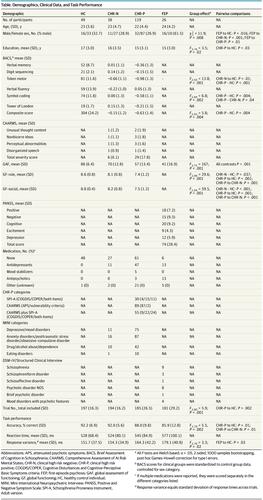JAMA Psychiatry ( IF 22.5 ) Pub Date : 2020-08-01 , DOI: 10.1001/jamapsychiatry.2020.0284 Tineke Grent-'t-Jong 1, 2 , Ruchika Gajwani 3 , Joachim Gross 1, 4 , Andrew I Gumley 3 , Rajeev Krishnadas 1 , Stephen M Lawrie 5 , Matthias Schwannauer 6 , Frauke Schultze-Lutter 7 , Peter J Uhlhaas 1, 2

|
Importance Psychotic disorders are characterized by impairments in neural oscillations, but the nature of the deficit, the trajectory across illness stages, and functional relevance remain unclear.
Objectives To examine whether changes in spectral power, phase locking, and functional connectivity in visual cortex are present during emerging psychosis and whether these abnormalities are associated with clinical outcomes.
Design, Setting, and Participants In this cross-sectional study, participants meeting clinical high-risk criteria for psychosis, participants with first-episode psychosis, participants with affective disorders and substance abuse, and a group of control participants were recruited. Participants underwent measurements with magnetoencephalography and magnetic resonance imaging. Data analysis was carried out between 2018 and 2019.
Main Outcomes and Measures Magnetoencephalographical activity was examined in the 1- to 90-Hz frequency range in combination with source reconstruction during a visual grating task. Event-related fields, power modulation, intertrial phase consistency, and connectivity measures in visual and frontal cortices were associated with neuropsychological scores, psychosocial functioning, and clinical symptoms as well as persistence of subthreshold psychotic symptoms at 12 months.
Results The study participants included those meeting clinical high-risk criteria for psychosis (n = 119; mean [SD] age, 22 [4.4] years; 32 men), 26 patients with first-episode psychosis (mean [SD] age, 24 [4.2] years; 16 men), 38 participants with affective disorders and substance abuse (mean [SD] age, 23 [4.7] years; 11 men), and 49 control participants (mean age [SD], 23 [3.6] years; 16 men). Clinical high-risk participants and patients with first-episode psychosis were characterized by reduced phase consistency of β/γ-band oscillations in visual cortex (d = 0.63/d = 0.93). Moreover, the first-episode psychosis group was also characterized by reduced occipital γ-band power (d = 1.14) and altered visual cortex connectivity (d = 0.74-0.84). Impaired fronto-occipital connectivity was present in both clinical high-risk participants (d = 0.54) and patients with first-episode psychosis (d = 0.84). Importantly, reductions in intertrial phase coherence predicted persistence of subthreshold psychosis in clinical high-risk participants (receiver operating characteristic area under curve = 0.728; 95% CI, 0.612-0.841; P = .001).
Conclusions and Relevance High-frequency oscillations are impaired in the visual cortex during emerging psychosis and may be linked to behavioral and clinical impairments. Impaired phase consistency of γ-band oscillations was also associated with the persistence of subthreshold psychosis, suggesting that magnetoencephalographical measured neural oscillations could constitute a biomarker for clinical staging of emerging psychosis.
中文翻译:

在新兴精神病期间,脑磁图测量的视觉皮层中的高频振荡与局部和大型网络中的电路功能障碍的关联。
重要性 精神病的特征是神经振荡受损,但缺陷的性质,疾病阶段的轨迹以及功能相关性仍不清楚。
Objectives To examine whether changes in spectral power, phase locking, and functional connectivity in visual cortex are present during emerging psychosis and whether these abnormalities are associated with clinical outcomes.
Design, Setting, and Participants In this cross-sectional study, participants meeting clinical high-risk criteria for psychosis, participants with first-episode psychosis, participants with affective disorders and substance abuse, and a group of control participants were recruited. Participants underwent measurements with magnetoencephalography and magnetic resonance imaging. Data analysis was carried out between 2018 and 2019.
Main Outcomes and Measures Magnetoencephalographical activity was examined in the 1- to 90-Hz frequency range in combination with source reconstruction during a visual grating task. Event-related fields, power modulation, intertrial phase consistency, and connectivity measures in visual and frontal cortices were associated with neuropsychological scores, psychosocial functioning, and clinical symptoms as well as persistence of subthreshold psychotic symptoms at 12 months.
结果 研究参与者包括符合临床高危精神病学标准的患者(n = 119;平均[SD]年龄,22 [4.4]岁; 32名男性),26例首发精神病患者(平均[SD]年龄,24) [4.2]岁; 16名男性),38名患有情感障碍和药物滥用的参与者(平均[SD]年龄,23 [4.7]岁; 11名男性)和49名对照参与者(平均年龄[SD],23 [3.6]岁) ; 16个人)。临床高风险参与者和首发精神病患者的特征是视皮层中β/γ带振荡的相位一致性降低(d = 0.63 / d = 0.93)。此外,首发精神病组的特征还在于枕叶的γ波段功率降低(d = 1.14)和视觉皮层连通性改变(d = 0.74-0.84)。临床高危参与者(d = 0.54)和首发精神病患者(d = 0.84)均存在额枕连接性受损。重要的是,间期相干性的降低预示了临床高风险参与者的阈下精神病的持续性(曲线下的接收者工作特征区域= 0.728; 95%CI,0.612-0.841;P = .001)。
结论和相关性 精神病发作期间视皮层的高频振荡受损,并且可能与行为和临床障碍有关。γ波段振荡的相位一致性受损还与阈下精神病的持续存在相关,这表明脑磁图测量的神经振荡可能构成了新兴精神病临床分期的生物标志物。











































 京公网安备 11010802027423号
京公网安备 11010802027423号